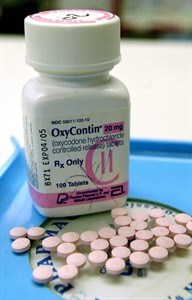
OxyContin tablets are seen at Brooks Drugs in Montpelier, Vt., in this July 19, 2001, file photo.
Image Credit: THE CANADIAN PRESS/AP-Toby Talbot, File
September 12, 2014 - 5:23 PM
TORONTO - Prescriptions for high-dose formulations of opioids like oxycodone and morphine jumped significantly in Canada between 2006 and 2011, despite guidelines advising doctors against giving such elevated doses to most patients, a study has found.
Researchers at St. Michael's Hospital in Toronto and the Institute for Clinical Evaluative Sciences found the rate of high-dose opioid dispensing across Canada increased 23 per cent during the six-year study, from 781 units per 1,000 people in 2006 to 961 units in 2011.
Put another way, that's almost one high-dose opioid pill or patch for every person across Canada, say the researchers, who reported their findings Friday in the journal Canadian Family Physician.
"We found that high-dose prescribing was widespread across the country, but the prevalence differed considerably between provinces," said lead author Tara Gomes.
Dispensing rates in Saskatchewan and Newfoundland and Labrador spiked dramatically, rising almost 85 per cent and 54 per cent, respectively; Alberta, up six per cent, and British Columbia, rising eight per cent, remained relatively stable.
Ontario had the highest dispensing rate at 1,382 units per 1,000 people — more than one per resident — while Quebec had the lowest rate at 368 units per 1,000 people.
Provinces also differed in which opioids were most often prescribed. In Alberta and Ontario, oxycodone was the top choice, while B.C. doctors most commonly prescribed morphine.
Gomes said there are a couple of factors likely driving the provincial differences in which of the highly addictive painkillers doctors choose to prescribe.
"One could be variations in how these drugs are covered on public drug programs," she said. "We know that in some provinces like Ontario and Alberta, they didn't have very many restrictions on access to oxycodone at the time of the study ... and those are the provinces where we see the higher rates of prescribing of high-dose oxycodone."
In B.C. and Newfoundland and Labrador, for example, hydromorphone was a restricted product and those provinces have some of the lowest rates of that drug at high doses.
Different marketing strategies by manufacturers may also have fed into increased dispensing rates of certain products in some provinces, Gomes suggested. For instance, Ontario's large population may have led to more aggressive promotion of newer opioids like oxycodone compared to jurisdictions with smaller populations.
"So in those provinces you might see older agents where clinicians historically have been more comfortable prescribing an older drug like morphine, for example, and they passed that on through training of residents and newer clinicians," she said.
The study found the per capita rate of high-dose opioid dispensing increased steadily in Canada between 2006 and 2008 before plateauing in 2009-2010, coinciding with the release of Canadian guidelines and a study showing that the rate of fatal opioid overdoses had increased dramatically in Canada.
Those guidelines designate opioid doses equivalent to 200 milligrams of morphine per day as "watchful doses," and doctors are advised to carefully consider the potential risks of addiction and overdose before prescribing a dose that exceeds that threshold.
"The evidence shows that these drugs can be effective for treating acute pain conditions for a short period," said Gomes, citing pain suffered by cancer patients as an example.
"Where the evidence is not as clear is whether these are really an effective pain-management option for long-term use" for treating such problems as chronic low back pain or knee pain, she said.
Research has shown that high-dose opioids can lead to overdoses and death, motor vehicle accidents and falls that cause serious fractures.
"These are the very potent, high-dose pills," said Gomes. "If somebody who's never taken an opioid before ingests one of these high-dose tablets, they could overdose just by taking one or two of these tablets because of the strength of the product."
Their potency is a risk for both patients prescribed the medications and recreational users who procure them on the street, she said.
Canada and the United States have the highest levels of prescription opioid use in the world. On average, more than 30 million high-dose tablets or patches are dispensed in Canada each year.
More than 180 million units were dispensed across Canada from 2006 to 2011, the study found. Almost half were oxycodone, followed by morphine, hydromorphone and fentanyl patches.
"On a national front, I think that we likely need a unified response to this opioid issue because we're seeing that across Canada there are high rates of use of these products," said Gomes.
But variations in the provinces, particularly in the type of these drugs being dispensed, suggests that a unified approach must be tailored to individual jurisdictions because a program that works in one province may not work in another, she said.
News from © The Canadian Press, 2014